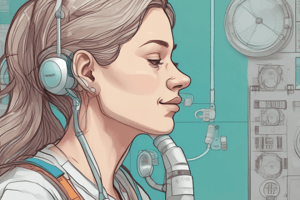Podcast
Questions and Answers
What is the main purpose of mechanical ventilation?
What is the main purpose of mechanical ventilation?
- To increase blood pressure
- To decrease venous return to the heart
- To support lung function artificially (correct)
- To apply positive pressure to the thorax
Which pressure gradient is calculated as the difference between the alveolar pressure and the pleural pressure?
Which pressure gradient is calculated as the difference between the alveolar pressure and the pleural pressure?
- Negative intrathoracic pressure
- Transpulmonary pressure (Ptp) (correct)
- Transairway Pressure (Pta)
- Transthoracic pressure (Ptt)
In positive pressure ventilation, what happens during exhalation?
In positive pressure ventilation, what happens during exhalation?
- Exhalation is passive (correct)
- Airflow in the chest stops
- Active inhalation occurs
- Pressure in the thorax decreases
What is the effect of spontaneous breathing on venous return to the right side of the heart?
What is the effect of spontaneous breathing on venous return to the right side of the heart?
Which pressure gradient is calculated as the difference between the alveolar pressure and the body surface pressure?
Which pressure gradient is calculated as the difference between the alveolar pressure and the body surface pressure?
What effect does positive pressure ventilation have on alveolar ventilation?
What effect does positive pressure ventilation have on alveolar ventilation?
How does positive pressure ventilation affect venous return to the right heart?
How does positive pressure ventilation affect venous return to the right heart?
What is the impact of positive pressure ventilation on renal output?
What is the impact of positive pressure ventilation on renal output?
How does positive pressure ventilation affect cerebral perfusion pressure (CPP)?
How does positive pressure ventilation affect cerebral perfusion pressure (CPP)?
What is a common complication associated with establishing an airway during positive pressure ventilation?
What is a common complication associated with establishing an airway during positive pressure ventilation?
Flashcards
Mechanical Ventilation
Mechanical Ventilation
Artificial support of lung function using positive or negative pressure to create intrapulmonary ventilation.
Apnea
Apnea
Absence of breathing.
Acute Ventilatory Failure
Acute Ventilatory Failure
Inability of the lungs to provide adequate ventilation to remove CO2.
Impending Ventilatory Failure
Impending Ventilatory Failure
Signup and view all the flashcards
Severe Hypoxia
Severe Hypoxia
Signup and view all the flashcards
Transairway Pressure (Pta)
Transairway Pressure (Pta)
Signup and view all the flashcards
Transpulmonary Pressure (Ptp)
Transpulmonary Pressure (Ptp)
Signup and view all the flashcards
Transthoracic Pressure (Ptt)
Transthoracic Pressure (Ptt)
Signup and view all the flashcards
PPV & Venous Return
PPV & Venous Return
Signup and view all the flashcards
Barotrauma
Barotrauma
Signup and view all the flashcards
Study Notes
Mechanical Ventilation
- Mechanical ventilation is an artificial support of lung function that uses positive pressure applied to the airway or negative pressure applied to the thorax or abdomen to create intrapulmonary ventilation.
- Mechanical ventilation can affect nearly every organ system in the body.
Indications for Mechanical Ventilation
- Apnea
- Acute ventilatory failure
- Impending ventilatory failure
- Severe hypoxia
Pressure Gradients
- Transairway pressure (Pta) is the difference between the pressure at the airway opening (Pawo) and the alveolar pressure (Palv).
- Transpulmonary pressure (Ptp) is the difference between the alveolar pressure (Palv) and the pleural pressure (Ppl).
- Transthoracic pressure (Ptt) is the difference between the alveolar pressure (Palv) and the body surface pressure (Pbs).
Spontaneous Breathing
- Negative pressure is created in the pleural space by the descending diaphragm, resulting in airflow into the chest.
- Air flow is directed to the dependent portions of the lungs.
- The same negative intrathoracic pressure augments venous return to the right side of the heart.
- Exhalation is passive, returning to the resting end-expiratory levels.
Positive Pressure Ventilation (PPV)
- PPV reverses the gradients of normal breathing, decreasing ventilation to the dependent portions of the lungs.
- PPV increases V/Q mismatch and intrathoracic pressure, decreasing venous return to the right heart and resulting in decreased cardiac output (CO) and blood pressure (BP).
Oxygenation with PPV
- PPV delivers an FiO2 of 100%.
- Increasing FiO2 improves hypoxemia in V/Q mismatch, hypoventilation, diffusion defect (+ PEEP), and shunt (+ PEEP).
Effects of Positive Pressure Ventilation
- Increased minute ventilation in hypoventilating patients, leading to retention of CO2 and hypercapneic respiratory failure.
- Increased alveolar ventilation, which has an inverse relationship to PaCO2.
- Increased V/Q ratio, resulting in an increased V/Q mismatch.
- Increased deadspace ventilation.
Cardiovascular Effects of PPV
- PPV compresses the intrathoracic veins, increasing CVP and decreasing venous return.
- PPV enhances the cardiac cycle in patients with LV dysfunction.
- PPV decreases LV afterload, potentially increasing cardiac output.
- PPV may decrease mean arterial pressure (MAP) and increase venous pressure, leading to diminished cerebral perfusion pressure (CPP).
Other Systems Affected by PPV
- Renal: PPV reduces urinary output by 30-50%.
- Gastic:
- Nutrition:
- Neurologic:
- Hepatosplanchnic:
- Airway:
- Sleep:
Complications of PPV
- Hazards of establishing the airway (intubation): teeth, lacerations, misplaced tubes
- Nasal tubes: infection
- Endotracheal tubes: infection, VAP, pressure sores, tracheal ischemia/edema
- Barotrauma
- Hypotension
- Decreased renal output
- Hyperventilation
- Suppression of the hypoxic drive
- Increased work of breathing (WOB)
Studying That Suits You
Use AI to generate personalized quizzes and flashcards to suit your learning preferences.




